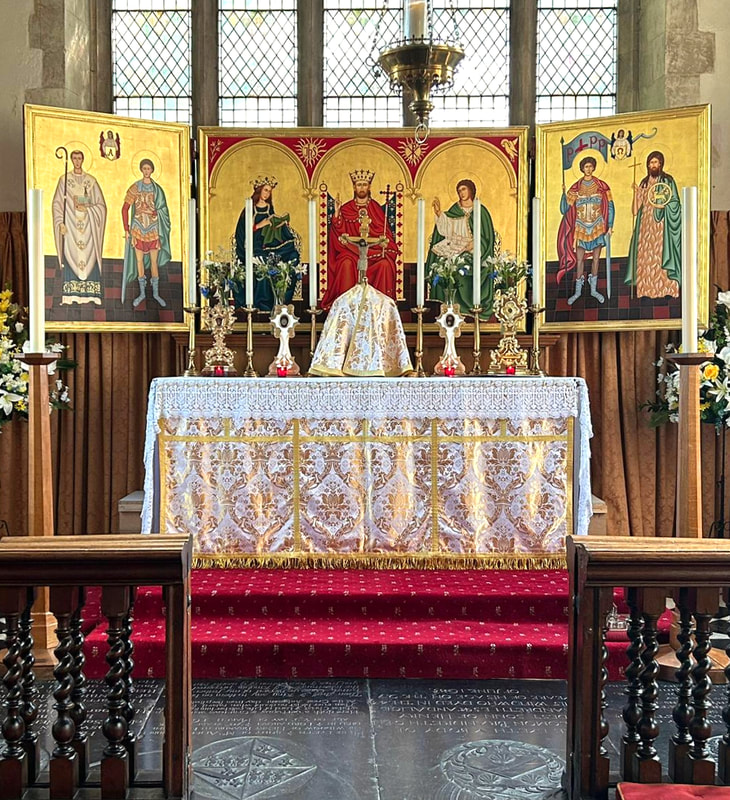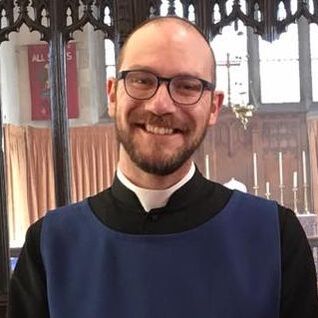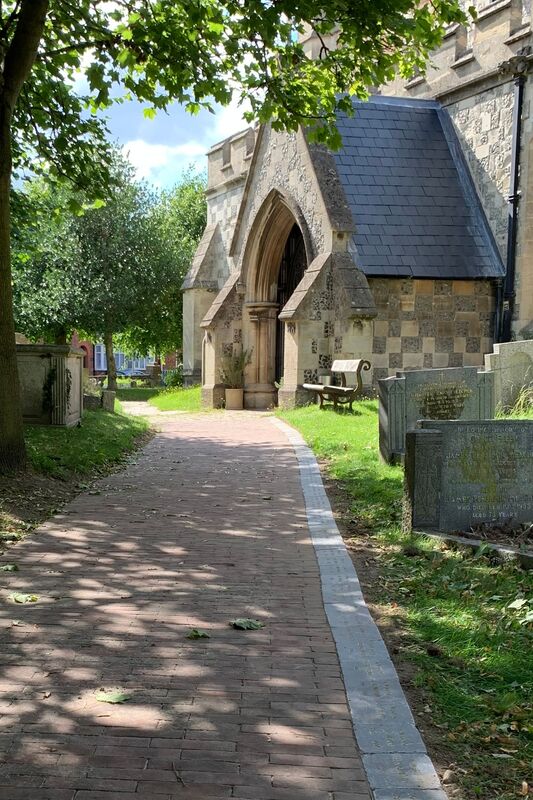|
A reflection on key aspects of parish life by the Priest-in-charge of Houghton Regis, Father Diego Galanzino.
As we receive the audited parish accounts and various reports about parish activities, the Annual Meeting gives us the opportunity for looking back at 2023, and to give thanks to God for his blessings, graces, and generosity towards us. As we do this, the first thing I would like to say is a big “thank you” to our churchwardens, members of the PCC, and volunteers for all their work and contributions to the life of our community and the ministry from our churches. I am also very grateful to all our supporters and benefactors who enable the ministry of All Saints’ to continue through their generosity. 2023 – Looking back Last year saw the conclusion of our biggest restoration project to date. This started in 2016 with a grant application to the National Lottery Heritage Fund. The first phase of the project concluded in 2019 with the expenditure of £250,000 on the outer fabric of All Saints’, but because of monetary constraints we had to postpone some of the works. It was only last year that we were able to tackle the remaining works (a complete overhaul of the drainage system for rain and surface water) with an expenditure of approximately £35,000 raised with the financial support of Beds and Hearts Historic Churches Trust, the National Churches Trust, and the Benefact Trust. A small grant from the Diocese (£500) allowed us to purchase new pavement signs for All Saints’ and to set up a children’s area with soft toys, a colourful tent, a picnic table, and Bible story books. This has proved a welcome addition to the space. A similar grant, yet to be spent, will enable us to improve our hospitality equipment at St Thomas’. We finally reordered the sanctuary, introducing steps to the high altar and the Preston Triptych in memory of Father Colin Gay. These works were carried out entirely through the contribution of members of the congregation. 2023 has also been the year when we started to pick up signs of consistent growth since the pandemic. Our congregation is growing and growing more diverse under many respects (age, nationality, ethnic and social backgrounds). This was noticed also by Bishop Richard during his last visit to us. The details of events, services, and attendance can be found in the report of the PCC. But, I hope you can see that here we have a few points already for which to be thankful to God who is good and faithful. 2024 – How are we doing now? This meeting gives us the opportunity to make the point of our situation in 2024 and to highlight both the challenges we are facing and the projects we need to work on next. Diversity: As I have said many times before, we are the Church of England, we are here for everyone in the parish of Houghton Regis regardless of their social background, walk of life, denomination, gender, sexual orientation, etc… Indeed, our distinct Anglo-Catholic tradition should inspire us in our work of welcome: no resident of our parish is outside our spiritual care. So, I am delighted to see that, as our congregation grows numerically, we are welcoming a number of people who are not necessarily cradle Anglicans or “churched” but feel comfortable in worshipping with us and becoming part of our church family. As great as this is, I would like to sound the faintest of alarm bells so that we are not going to hinder what God is doing here… Let me take an analogy from daily life. People from wildly different backgrounds and walks of life use the same supermarket, but if you gathered all these in one place, they would not necessarily identify themselves as a community: the “Morrisons community”, for example. No; it is more likely that they would identify themselves as completely independent people who happen to use the same services because of geographical convenience or good marketing. We cannot risk All Saints’ to mirror this. So, although we are overall very good at making people welcome here, we must work also to include, connect with, befriend, encourage, and genuinely care for everyone with the aim of building up the one body that is the Church; both a community and a place where diversity is valued and respected as an integral part of our shared life in Christ. At the end of the day, it is the Lord himself who said, “my house shall be called a house of prayer for all peoples” (Isaiah 56:7). Events for welcomers, stewards, and sidesmen will be offered later in the year to help focus our attention on this. Discipleship: We run a weekly bible study, the Gospel Reading Group, which examines the set gospel text for the coming Sunday. However, we ought to increase our discipleship and learning schedule to appeal to those who work and those outside our church community. For this we must identify suitable times and volunteers who would both help with the running of the events and by just being there as a critical number. Volunteering: As I expressed in my opening remarks, the work of the parish could not be done without the invaluable help of our volunteers. So, I would like to offer a couple of remarks about this subject. First, we should be encouraging as many people as possible to volunteer. There are a variety of things people can do, from being involved in the liturgy or the PCC, to simply keeping the church open for visitors or help with the cleaning. Secondly, I must ask current volunteers to be affirming, generous, and gracious towards one-another and towards newcomers, fostering collaboration and giving confidence to new people in coming forward. Financial Situation: Financially speaking, the Parish of Houghton Regis, is not in a good place. You may have noticed that the projects listed earlier rarely mention actual expenditure from our part. This is because we can only afford the essentials. The current accounts for All Saints’ and for St Thomas’ are not worth mentioning here (details are presented in the audited accounts) because they work hand to mouth. Indeed, this year Kirsty has had to borrow money from the restoration fund to make ends meet and honour our monthly financial commitments. Our reserves are very small. All Saints’ has between £8,000 and £10,000 to its name in the Restoration Account (that is pending VAT returns); we have just under £12,000 in investments (CCLA) from the old Christ Church funds which can only be spent for the reordering of the church (that is, to enhance the liturgical space. For example, relocating the font); and St Thomas’ has about £14,000 in investments (CCLA) kept for its own fabric, which is also ageing. The main financial pressures for our parish are twofold. First, we have our contribution towards Common Fund (or Parish Share) to the Diocese of St Albans. This Fund enables essential support for parishes (for example, Safeguarding support and training) and ministry in the wider Church, paying and housing stipendiary clergy, training of priests and lay ministers, and (crucially for us) supporting less well-off parishes. There are two conflicting arguments on how much our parish should be paying. On one hand, the current demand is too much of an ask for an area marked by high levels of deprivation. On the other hand, a parish of this size should be contributing in the region of £60,00 to £80,000 per year. The diocesan demand to us is currently in the region of £50,000 per year, but perhaps we could bear in mind a target of £65,000. However that may be, in 2023 we paid £19,400 and this year £4,500 to date. Consequently, each year we gain fresh arrears and, although these are not enforceable like debts because the Parish Share is a contribution not a tax, we are technically in the red with the Diocese of well over £100,000. The second financial pressure is represented by utility bills and insurance. In 2023 we paid £16,023.49 between gas and electricity (about £12,000 of which were on All Saints’), and about £6,000 in insurance. In the year to date, we have paid £5,882.54 (about £4,000 of which were on All Saints’). As you can see, the combined amount of these bills for 2023 is more than our Common Fund contribution. Let me reassure you that we are very careful stewards of the donations we receive from people. We are making savings in every possible area, people entitled to the refund of expenses are not submitting claims, we are only buying flowers for three or four times a year, and a number of volunteers are consistently purchasing consumables (for the liturgy, coffee mornings, and the office) willingly out of their own pockets. I have encountered serious misgivings about our finances. Many people believe that we have lots of money. This was not helped by the development of Linmere, which was advertised as “Brought to you by the Diocese of St Albans” and other two companies. Yes, there was a sizeable amount glebe land in the parish, once used to provide a living for the Vicar, but this was transferred to the Diocese by law decades ago. The glebe now generates an income for the Diocese as a whole and not for the parish. Similarly, the Diocese made over £600,000 in the sale of the Vicarage and only a small part of these funds has been used to update and refurbish the Clergy House (and only after cashing in seven years of rent anyway). None of this money benefits the Parish of Houghton Regis. Although what is happening here is also happening in countless other parishes across England, I feel and completely understand the frustration of parishioners with this situation. A parish which only fifteen years ago had two priests, two houses for them, two retired clergy, and 20,000 people, is now left with higher bills, one priest, one house, no assets, and a forecasted population of 35,000 which we must reach out and minister to (creatively, as they say). With what resources? Linmere: This leads me to talk about the new expansions of our town. For years the Diocese and the PCC have been in a deadlock about the way forward in bringing a Christian presence to Linmere. Fundamentally, the disagreement is about resourcing. Why is the Diocese prepared to resource something from scratch, but not to equip the existing parish for the work of ministry – even though it is making substantial gains from glebe land and sale of the vicarage (see above)? But there have been other questions too, especially concerning the future relationship between the Parish of Houghton Regis and a New Worshipping Community. Would this project be wholly independent from All Saints’? Would it endorse a markedly different tradition? Last year the PCC met with Bishop Richard and two other Diocesan officers for a meeting on this subject which turned out to be very frustrating for all parties involved. Indeed, PCC members quickly understood that all the options on the table had been precluded to them apart from the one favoured by the Diocese. However, out of this frustration and a frank exchange of opinions came something new… maybe. I have recently met with the Director of Mission for the Diocese and the Deputy to work on a revised plan which would see the Parish of Houghton Regis and a New Worshipping Community working “in understanding” with one another and valuing each other’s charisms. I understand that parishioners want to see a fail-safe or an independent mediation mechanism to be introduced in this agreement, should relationship between the two community or with the Diocese deteriorate. The Diocese would purchase a property on Linmere and employ a pioneer minister (probably a lay minister) to start the New Worshipping Community. This plan has similarities with what happened on Parkside in the 70s which then led to the construction of St Thomas’. However, the clear difference is that the new project would necessarily be non-sacramental in its focus, leading to question who would be responsible for the pastoral offices (Baptisms, Weddings, and Funerals) on the new estate? And what emphasis (or lack thereof) would there be on the celebration of the Eucharist and the sacraments? And as part of this, the Diocese would help the PCC in securing a grant from the Church Commissioners for a suitable three-year mission project identified by the parish. This is great news, but “help in securing a grant” from a third party is not the same as “the parish would receive a grant” as we know all too well from our restoration projects. There are also open questions about the sustainability of such a Community, its worshipping space, and what sense of belonging it would be able to instil. There are very few local examples where this type of initiative continue to be successful in the long run. To this, I would also add a slightly pedantic observation about the economic impact on Common Fund. Given that the New Worshipping Community would minister in an area of the town which is going to be broadly richer than the rest, they would be able to potentially receive more money in donations pro capita, while we would continue to minister to areas marked by high levels of deprivation. Furthermore, the New Worshipping Community will not be burdened with Common Fund for a number of years or with the care of any building, while we will continue to have to balance the books with Parish Share, bills, and restoration projects. I do not think this is either fair or wise. Fabric of All Saints’ Sound System - A new sound system has been installed just last month. As people pointed out over the years, our previous set-up was not adequate. However, it did take a lot of money to get here, and consequently a lot of time spent in fundraising and securing grants. The new system has been paid through the restoration account (i.e. parish fundraising), but we would have not been able to afford it without the substantial contributions of a few Central Bedfordshire Councillors who donated through their discretionary funds (and one of them out of their own pockets too!), the Benefact Trust, and a member of the congregation who wishes to remain anonymous. Moving forwards, this year the PCC will need to consider the following projects. Toilets: We are aiming to completely refurbish the toilet at All Saints’ making it accessible to wheelchair users and those using walking aids (though the disabled facilities at St Thomas’ also would benefit from a complete refit). Celia and Kirsty are already working on possible grants. Although we cannot do substantial alteration to the fabric easily, because of the nature of our treasured medieval building, we must do our best to make sure we provide good facilities that are accessible and useful to everyone visiting the church. All Saints’ may be legally exempt from certain accessibility requirements, but that does not mean that we should overlook our duties of welcome, hospitality, and care. Solar Panels and Heat Pump: The staggeringly high utility bills (see below) demand that we explore the possibility of installing solar panels on the church roof and a heat pump to replace the current gas boiler. Of course, doing so would also reduce quite heavily our carbon footprint. There are local examples, such as the Priory Church of St Peter, Dunstable, where solar panels have recently been installed on a Grade I listed building. Furthermore, our architect has worked on projects that included the introduction of heat pumps in ancient buildings. These two projects cannot be seen in competition with one another, and the PCC will have to endeavour to work on both of this. Relocation of the Font: We have been talking for a few years about the possibility of relocating the font to the crossing (between the Wardens’ pew-fronts), and we have received both guidance and positive comments about the project from the DAC. The move would enhance greatly the celebration of baptisms and better display the font for visitors, while also highlighting the artistic value of the Norman font. The money for this project would come from the Christ Church funds (see below), not from parish fundraising.
0 Comments
Your comment will be posted after it is approved.
Leave a Reply. |
Archives
July 2024
Categories
All
|



 RSS Feed
RSS Feed


